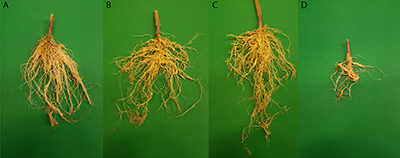Instructor Notes
1. Discussion of Learning Goals
Plant-parasitic nematodes are often challenging to incorporate into laboratory sections of undergraduate plant pathology courses. In addition to being obligate parasites, plant-parasitic nematodes typically have generation times that span several weeks. Time constraints often mean that nematodes are only studied for one week during a semester-long undergraduate plant pathology course. In our course (a three- credit undergraduate course comprising mainly sophomores and juniors), we typically follow the nematology lectures and laboratory unit with a section on epidemiology. We utilize the disease rating data the students gathered during the nematology lab to discuss concepts regarding data analysis including basic statistical methods.
2. Preparation of Materials
Timing:
- 2-3 months before class: Plant tomatoes
- 1-2 months before class: Inoculate with nematodes
- 1 hour before class: Gently remove plants from pots, rinse gently with water to remove adhering soil, and lay on moist paper towels
Seed and Pathogen:
Root-knot nematodes are found worldwide. We use a population of
M. incognita originally isolated from soybean in southern Illinois (courtesy J. Bond). We have also utilized a population of
M. hapla originally isolated from a commercial tomato grower in north-west Illinois. Both populations are available upon request from Nathan Schroeder. The galls produced by
M. hapla tend to be smaller than those produced by
M. incognita. For
M. incognita, we find that ‘Rutgers’ tomato produces consistent results and is available from many commercial seed catalogs. Since the galls produced by
M. hapla are smaller, we recommend using lettuce as the host plant with this nematode species.
Plant and Nematode Infestation:
We begin germinating seeds approximately 2-3 months prior to the laboratory. Seeds are sown in potting mix until emergence, then transferred to 6-inch diameter pots with pasteurized sandy loam field soil, and maintained in a greenhouse. If pasteurization is not an option, a 2:1 mixture of sand to vermiculite can be used.
Inoculation of pots should occur 6-8 weeks prior to the laboratory. Galling can be observed as soon as one month after inoculation with high inoculum levels, but are much clearer after 2 months. As the goal of the laboratory is to simply achieve different levels of galling, the quantification of inoculum does not require precision. We have simply removed variably sized galls from a previously infected plant and buried it next to the newly emerged tomato plant. We always keep one or more plants as non-inoculated controls. If greater precision is desired, a traditional root-knot nematode extraction method can be used to recover eggs (Hussey and Barker 1973). In this case, plants are then inoculated with a series of increasing numbers of eggs (e.g. 0, 500, and 5,000 egs) by creating one inch deep depressions surrounding the plant and using a pipette to infest the soil. Each inoculum level is replicated three times
Handling of Nematodes:
Small (ca. 2 cm length) galls removed from the root system can be used to isolate nematodes. Students can use the scalpel to cut the gall into five or six sections. Eggs, juveniles and adults should be apparent under a dissecting scope. Large galls may contain several juveniles or females. Nematodes can be transferred individually to a small drop of water on to a microscope slide using a nematode pick. Picks can be made by gluing an eyelash onto the end of a toothpick. Many students will struggle with using a nematode pick. Alternatively, Pasteur pipettes can be used to withdraw a small amount of water and nematodes onto the microscope slide. However, care is needed with the latter method in order to not dispense too much liquid and thereby lose the nematode on the microscope slide.
3. Explanation of Expected Results
Various degrees of galling should be observed (Fig. 1). Students, typically, assign ratings that are reasonably consistent with each other. However, occasionally individual students will give remarkably different ratings to the same plant. For example, the non-infested control plants (Fig. 1A) have recieved ratings from zero to two. A highly infested plant (Fig. 1D) received ratings from six to nine. We use these variable data to discuss potential observer bias in disease ratings and mechanisms that may reduce observer bias such as blinding treatments. Plants receiving similar inoculation amounts will often vary substantially in the extent of galling. We use this variability to discuss the importance of replication. Similarly, the post-lab questions can stimulate discussions on the advantages and disadvantages of using symptoms versus signs when assessing disease. We will typically collect the data from the students and then use these to discuss aspects of data analysis during subsequent lectures on epidemiology.

Various stages of nematodes can be dissected from galls (Fig. 2A) and observed under a compound microscope (Figs. 2B-D). When using the dissecting microscope, students should be encouraged to utilize incident lighting when cutting open the gall and transmitted lighting when looking for nematodes.
Instructor Notes Literature Cited
Hussey, R. S., and Barker, K. 1973. A comparison of methods of collecting inocula of Meloidogyne spp., including a new technique.
Plant Disease Reporter. 57:1025–1028.
